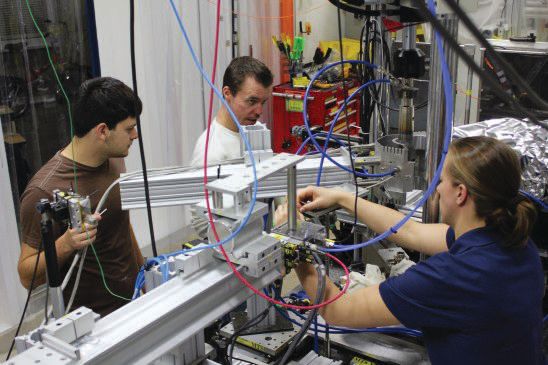In situ testing of jet engine turbine blade coatings
Dr. Neil Canter, Contributing Editor | TLT Tech Beat December 2014
Researchers develop an in situ process for evaluating thermal barrier coatings under the severe operating conditions in a jet engine..
KEY CONCEPTS
•
Thermal barrier coatings based on ceramics are used to protect turbine blades from the extremely high temperature conditions present in jet engines.
•
A new approach for evaluating thermal barrier coatings through the use of an
in situ process has been developed.
•
Three experimental strategies have been implemented that show the formation of significant interface strains, particularly when a thermal gradient is present in the coating.
COATINGS CAN PLAY A PIVOTAL ROLE IN ENHANCING THE PERFORMANCE OF SPECIFIC COMPONENTS in automotive and industrial applications. A prime example was noted in a previous TLT article which discusses a coating for a piston skirt used to guide a piston in moving up and down in the cylinder of an internal combustion engine (
1).
The purpose of the piston skirt coating is to reduce friction and provide scuff resistance as the engine is in operation. The article discusses the development of a new piston skirt coating based on a blend of graphite, molybdenum disulfide and carbon fibers. A further reduction in friction by 18 percent and a substantial reduction in wear were achieved in testing the new coating.
A different type of challenge is presented in a jet engine where turbine blades rotate at high speeds under extreme high-temperature conditions. To protect turbine blades, thermal barrier coatings were developed.
Seetha Raghavan, associate professor in the department of mechanical and aerospace engineering at the University of Central Florida in Orlando, Fla., says, “Thermal barrier coatings are based on ceramics and are very effective at protecting the blades from the heat present in the jet engine. This enables the turbine blades to maintain high performance over long operating periods at temperatures ranging from 1,100 to 1,200 C.”
Thermal barrier coatings currently used are composed of three layers. Raghavan says, “The top coat is a yittria stabilized zirconia ceramic that is able to handle the high temperatures in the engine. A metallic bond coat, composed of an alloy of nickel, cobalt, chromium, aluminum and yittrium, binds the top coat to the superalloy blade. The third layer is a thermally grown oxide that develops at the interface between the ceramic and metal layers during the operation of the engine.”
With the success of these coatings, the question arises about the need for doing additional research. Raghavan replies, “The stresses developing within the thermally grown oxide layer are dependent upon several factors, including the specific coating, how the coating is manufactured, operating temperatures and engine shutdown periods. Under high-temperature conditions, various layers expand differently, leading to compressive residual stresses that are linked to eventual coating degradation and damage.”
The objective of the thermal barrier coating is to operate at an optimum level over the lifetime of the engine. Raghavan says, “We need to better understand the variation of these stresses under operational conditions to better design future coatings.”
Previous work in evaluating thermal coatings has been done in an
ex situ manner where the thermal coatings were examined after use. Raghavan says, “These fatigue studies were very useful, but they were limited in not being able to give an exact view of strain evolution within the thermal barrier coating during operation.”
A new approach is needed to try and evaluate the thermal barrier coating while it is exposed to the severe operating conditions in a jet engine. Such an approach has now been developed.
SYNCHOTRON’S X-RAYS
Raghavan and her associates at the University of Central Florida, in collaboration with the Institute of Materials Research at the German Aerospace Center, Cleveland State University and Argonne National Laboratory, have developed an
in situ process for evaluating thermal barrier coatings under the actual operating conditions of a jet engine. The group placed a thermal barrier coating on a nickel-based superalloy substrate in a specially designed compact furnace where the sample was bombarded with x-rays produced by Argonne’s Synchotron. Upon impact with the coating, the extent at which the x-rays diffracted provides information on the condition of the coatings and to what extent strains have been formed.
Figure 1 shows the researchers assembling the experimental setup. Three types of experiments were conducted to simulate various aspects of flight.
 Figure 1. Researchers are shown assembling the experimental setup used in the in situ testing of thermal barrier coatings used in jet engines. (Courtesy of the University of Central Florida)
Figure 1. Researchers are shown assembling the experimental setup used in the in situ testing of thermal barrier coatings used in jet engines. (Courtesy of the University of Central Florida)
“We first wanted to simulate conditions found during a short-haul flight where the outer surface temperature of the coating is raised over a 20-minute period to 1,000 C, maintained at that temperature for 40 minutes and then ramped down to room temperature,” Ragahavan says.
“Our second experimental strategy was to increase the mechanical load in a stepwise manner, as the temperature is increased to 1,000 C in order to maximize centrifugal loads and see how this impacts the evolution of strains developed in the coating,” she adds. “The third experimental approach is to uniformly heat the sample up to 1,000 C and then cool the inner surface of the substrate at various rates while keeping the surface temperature constant to establish a thermal gradient and determine what effect this has on strain formation.”
Initial results from all three experimental strategies have already provided insight on the dependency of strain formation during operating conditions. Raghavan says, “We have identified significant interface strains developing, particularly in the presence of a thermal gradient in the coating.”
Future work will involve studying the formation of the strains in coatings at various stages of aging and investigating the creep behavior and creep response of the thermal barrier coatings over time.”
Additional information on this research can be found in a recent publication (
2) or by contacting Raghavan at
seetha.raghavan@ucf.edu.
REFERENCES
1.
Canter, N. (2011), “Advanced piston skirt coating,” TLT,
67 (2), pp. 10-11.
2.
Knipe, K., Manero, A., Siddiqui, S., Meid, C., Wischek, J., Okasinski, J., Almer, J., Karlsson, A., Bartsch, M. and Raghavan, S. (2014), “Strain response of thermal barrier coatings captured under extreme engine environments through synchrotron X-ray diffraction,”
Nature Communications,
5:4559 DOI:10.1038/ncomms5559.
 Neil Canter heads his own consulting company, Chemical Solutions, in Willow Grove, Pa. Ideas for Tech Beat items can be sent to him at neilcanter@comcast.net
Neil Canter heads his own consulting company, Chemical Solutions, in Willow Grove, Pa. Ideas for Tech Beat items can be sent to him at neilcanter@comcast.net.